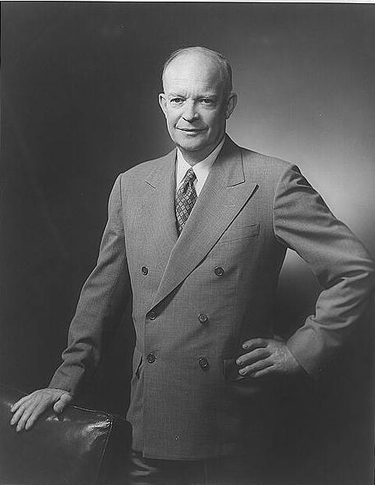end of header
History
You are here: Census.gov › History › Through the Decades › Overview › 1960 Overview
Overview
1960 Overview
1960

Dwight D. Eisenhower was President of the United States
on Census Day, April 1, 1960.
Enumeration
1960 marked the birth of the first mail-out census. Earlier censuses had used self-enumeration on a limited scale, but 1960 was the debut for this technique as a primary method for the collection of population and residential data. The postal service delivered questionnaires to every occupied housing unit. Householders were asked to complete the questionnaire and hold it for an enumerator to pick up.
Enumeration efforts were divided into two stages. The first stage concentrated on the quick collection of a few data items for every person and dwelling unit- information available from responses to questions on the questionnaire that had been delivered to every household. The second stage focused on the collection of more detailed economic and social information from a sample of households and dwelling units. Second stage questionnaires were hand-delivered by enumerators when they came to pick up the first form. Households receiving the second questionnaire were asked to complete the form and mail it to their local census office in postage-paid envelopes provided by enumerators.
In areas of low population density, the two-staged enumeration was combined to allow enumerators to collect and record sample data at the same time they came to fill out the general questionnaire.
Sampling
Additional sample questions were asked of 25 percent of the population. In urban areas (accounting for about 80 percent of the nation's population), enumerators carried questionnaires containing the sample population and housing questions for every fourth housing unit. If the units were occupied, the householders were asked to complete the sample questionnaires and mail them to district offices. If the units were vacant, the enumerators completed the questionnaires.
The greater use of sampling meant that the totals for some less populated areas were subject to moderate amounts of sampling variation, which did not significantly impair the usefulness of the statistics gathered. Using a 25 percent sample of households eliminated nearly 75 percent of the processing expenses that would otherwise be required.
Additional questions, which had been discussed but not included in several past censuses, focusing on place of work and means of transportation to work were added in 1960.
Technological Advancement
Computers processed nearly all data from the 1960 census. For the first time, the Census Bureau used a film optical sensing device for input to computers (FOSDIC). This machine "read" and converted to code on magnetic tape data appearing on returned questionnaires thus eliminating the time and expense for the previously necessary step where clerks entered the data on punch cards. The questionnaires for 1960 were designed so that respondents could indicate their answers by marking small corresponding circles on the page. The completed questionnaires were photographed onto microfilm with automatic cameras; FOSDIC then read the blackened dots (which appeared as clear holes on the negative film) and transferred the data they represented to magnetic tape for the computer at a speed of 3,000 items per minute. Later versions of the FOSDIC device were able to process up to 70,000 items per minute.
Further Information
- A detailed procedural history of the 1960 census is available in 1960 Censuses of Population and Housing: Procedural History [66.7 MB]
- A wide variety of historical statistics from this and other decades is available in Historical Statistics of the United States: Colonial Times to 1970. It is available as a PDF [74.4MB] or 2-part ZIP file: Part I [52.2MB] | Part II [66.1MB].
- Reports and statistics from the 1960 census
Comments or suggestions?




